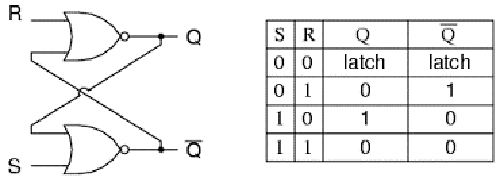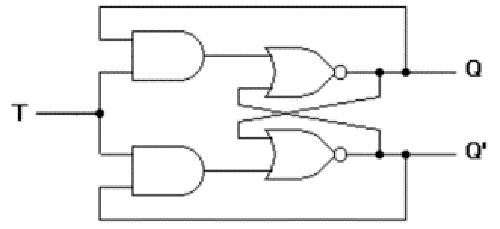Difference between Latch and Flip-Flop

We are not only transmitting information with the help of digital electronics, but also storing it effectively. In information technology when storage comes into the picture, we always think of the databases. Apart from that, the concept of latches and flip-flops are widely used to store data as bit format, especially when the actual calculation takes place. We can take it like the databases are how we imagine our data from the exterior whereas the latches & flip flops actually handle it internally. So they are the building blocks that act as fundamental elements to our computers, or any type of electronic systems. Before we go to the actual difference between latches and flip flops, we should understand what they really are and how they work? Let’s get into it now.
What is a Latch?
A Latch is a circuit element that alters the output based on the current input, previous input, and previous output. It is very simpler in its construction as we need to send the inputs to it and would get the outputs on the other side. There are four different types of latches and they are as follows.
- SR Latch: It is one of the simplest electronic circuits built with two ‘NOR’ gates. Here the output of the first gate is sent as one of the inputs to the second and vice versa. The two actual inputs are generally referred as ‘Set’ – ‘Reset’ and hence it has got the name as SR latch. Just look at inputs and outputs of this Latch in the below picture. The table in the picture is referred as truth table and represents the inputs & outputs in a simpler tabular form. Here, ‘S’ and ‘R’ are the inputs to the logic gates and ‘Q’ and ‘Q’ are the outputs.

- D Latch: It has got different names like Data Latch, Transparent Latch or Gated Latch. Here, there is only a single input and the output varies based on a control signal named as ‘Enable’ signal. Here is the input and output combination of D latches with respect to the enable signal.

- JK Latch: It has been developed to overcome the switching problems with the SR latches. From the below image, you could notice the third input to the gates and it is fed to overcome switching issues.

- T-Latch: It can be formed by using a shorted input to the JK Latch. Here, the letter ‘T’ stands for ‘Toggle’ as the output toggles based on the input.


The knowledge and understanding of the working principles of these latches would be extremely helpful to differentiate it from the flip flops. That is why we have been discussing these circuit setups and truth tables in detail. Let us also look at what a flip flop is and how it works?
What is a Flip Flop?
The flip-flops are built from latches and it includes an additional clock signal apart from the inputs used in the latches. It is capable of storing the binary values i.e. 0 or 1. As they are built from latches, we can again have four different types of flips flops based on the respective latches. So if you build it from an SR latch, then you would get an SR flip-flop by giving an additional clock signal to the latch. From the below, notice how the clock signal ‘C’ is sent as input to the JK flip-flop.

Are they built from?
Latches are built from logic gates to form sequential circuits. It never bothers about the clock or timely input. But in the case of flip flops, they are built from latches with an additional clock signal to form sequential circuits. The timely input is given much importance in flip-flops and the output gets changed from time to time.
When does the output changes?
In latches, the inputs are continuously checked and the output is altered according to the input. There is no worry about the time duration while computing the output. In Flip flops, the timely output matters the most. Even with flip flops, the inputs are checked continuously but the outputs get changed based on the clock signal. It means that we can set our own duration for the changes in the input to get reflected in the output.
Are they sensitive to?
Base on the pulse duration, the latch can send or receive data. So we can transmit as long as the input switch is ‘On’. So the sensitivity here is with respect to the input pulse duration whereas in flip flops it is with respect to the change in the clock signal. So, flip flops never alter the output until it detects a change in the input clock signal.
How do they work?
Latches work based on the input functions but flip flop work based on the clock signals. The timely output is the basic element that differentiates a flip-flop from a latch.
How are they triggered?
In latches, the binary inputs i.e. 0 or 1 play an important role in triggering the outputs. They can even be described as level-triggered as it reacts either in the level ‘0’ or in the level ‘1’. In flip-flops, the output gets triggered based on the ‘+ve’ or ‘-ve’ pulses of the clock. So it can better be described as edge triggered while considering when it reacts.
Which can be used as a register?
In electronic devices, registers play an important role to hold the actual data during the manipulations are transmissions. These registers should be more sophisticated rather than just sending output based on binary inputs. Also, they do require the involvement of clocks signals for real time transmissions. In order to such functionalities, we obviously require flip-flops cascaded according to the needs. Therefore, flip flops can only act as registers and the latches can never solve the purpose here.
Which is synchronous?
As we all know, synchronization generally refers to up to date in our communication system. You could have synchronized your mailbox with the server as and when needed. Again, the time plays an important role when it comes to synchronization. Latches are nothing to do with the time or clock signals but flip flops do use it. Therefore, flip flops carry synchronous transmissions whereas latches are asynchronous.
For a better understanding, let us look at the above differences in a tabular form.
| Concepts | Differences between | ||
| Latch | Flip Flop | ||
| 1 | What is it? | A Latch is a circuit element that alters the output based on the current input, previous input, and previous output. | The flip-flops are built from latches and it includes an additional clock signal apart from the inputs used in the latches. |
| 2 | Types | There are four types of latches namely SR Latch, D Latch, JK latch, and T Latch. | There are four types of flip flops namely SR Flip-flop, D Flip-flop, JK Flip-flop, and T Flip-flop. |
| 3 | Built from | They are built from logic gates to form sequential circuits. | They are built from latches with an additional clock signal to form sequential circuits. |
| 4 | Output changes | When there is a change in the input during the continuous input checking process. | Of course, the outputs are computed based on the inputs during the continuous input checking process but they are computed only when the time signal is ‘+ve’. |
| 5 | Sensitive to? | It is sensitive to the input switch and we can transmit data as long as it is ‘On’. | It is sensitive to the clock signals and it never alters the output until there is a change in the input clock signal.
|
| 6 | How do they work? | It works purely based on the binary inputs. | It works based on the binary inputs as well as on the clock signal. |
| 7 | Trigger Type | It is level triggered as the output gets changed based on the binary levels ‘0’ or ‘1’. | It is edge triggered as the output gets changed based on the ’+’ or ‘-’ clock signals. |
| 8 | Can be used as a register? | No. As registers need more sophisticated electronic circuits where time plays an important role. Here we miss the clock or time signals and hence it cannot be used as a register. | Yes. It includes clock signals in its inputs and therefore, cascaded flip-flops can be used as registers. |
| 9 | Synchronous? | No. It is asynchronous as it never works based on the time signals. | Yes. It is synchronous as it works based on the clock signals. |
Modern day electronics require up to date information in the most case and hence the use of flip flops are inevitable. But we cannot build a flip-flop without the basic concept of latches. Therefore, the operation of flip-flops is dependent on the mechanism of latches and, in turn, the latter uses logic gates for its functioning. Though we have pointed out many differences between the two, the basic difference is the timely output. With that as the base, the other differences arise automatically.
- Difference Between Facetime And Skype - August 31, 2017
- Difference between YouTube And YouTube Red - August 23, 2017
- Difference between Online UPS and Offline UPS - August 23, 2017
Search DifferenceBetween.net :
2 Comments
Leave a Response
References :
[0]https://www.edgefx.in/digital-electronics-latches-and-flip-flops/
[1]http://www.asic-world.com/digital/seq4.html
[2]https://electronics.stackexchange.com/questions/21887/difference-between-latch-and-flip-flop
[3]http://www.idc-online.com/technical_references/pdfs/electronic_engineering/Difference_between_a_latch_and_a_flip_flop.pdf

If you are still struggling to understand the concept of Latches vs Flip Flop, here we are to help you learn this topic in minutes with this concepts-made-easy tutorial by Mr. P R Sivakumar- CEO, Maven Silicon.
Thank u very much